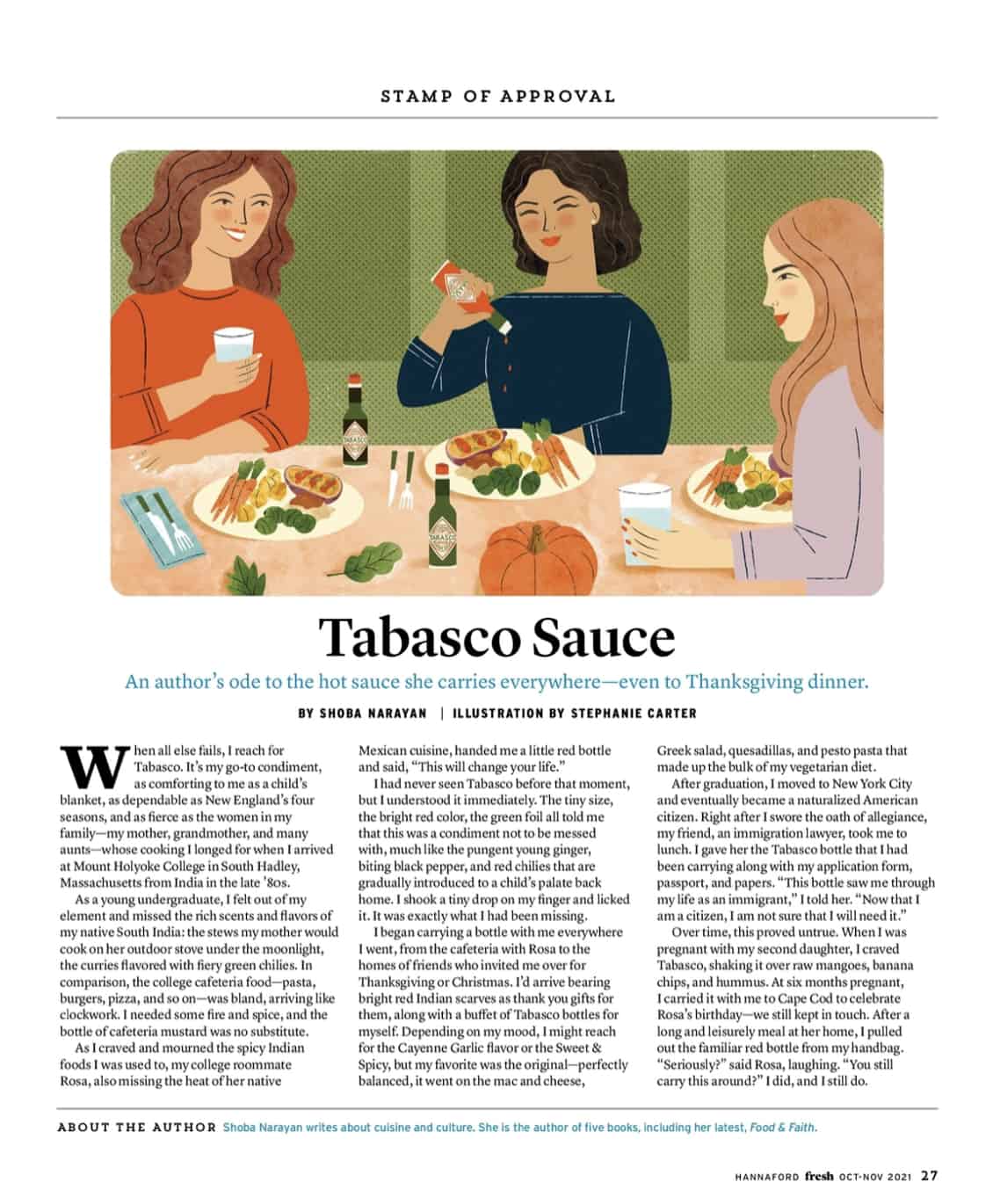When all else fails, I reach for Tabasco. It’s my go-to condiment, as comforting to me as a child’s blanket, as dependable as New England’s four seasons, as fierce as the women in my family—my mother, my grandmother, and my many aunts—whose cooking I longed for when I arrived at Mount Holyoke College in South Hadley, Massachusetts, from India as a young undergraduate in the late ’80s.
At school and out of my element, I missed the stews my mother would cook on her outdoor stove under the moonlight, the dishes that teemed with the rich scents and spicy flavors of my native South India. In comparison, the cafeteria food was bland and arrived like clockwork: Pasta on Mondays, ratatouille on Tuesdays, burgers on Wednesdays, pizza on Fridays, and so on. I yearned for the fiery green chilies that flavored the curries back home. I needed some fire and spice—and that bottle of cafeteria mustard was no substitute.
As I craved and mourned the spicy Indian cuisine I was used to, my college roommate Rosa, also missing the heat of her native Mexican cuisine, handed me a little red bottle and said, “This will change your life.” It did.
I had never seen Tabasco before that moment, but I understood it immediately: The tiny size, the fiery red color, the green cap—it all told me that this was a condiment not to be messed with, much like the pungent young ginger, biting black pepper, and fiery red chilies that were slowly introduced to a child’s palate back home, a little at a time. I shook a tiny dollop on my forefinger and licked it. The mixture of heat and spice was sublime. I immediately shook it all over the Gazpacho soup and discovered that it transformed from gazpacho to what I would since call flamenco.
Rosa and I began spiriting Tabasco sauce in our backpacks to douse over lackluster dorm food. I carried a bottle with me no matter where I went—including to the homes of friends who invited me for Thanksgiving or Christmas. I came bearing bright red Indian scarves as thank you gifts for them and a buffet of Tabasco bottles for me. Depending on my mood, I might reach for the Cayenne Garlic bottle or the Sweet & Spicy, but my favorite was the original—perfect for sprinkling on the mac and cheese, Greek salads, quesadillas, and pesto pastas that soon made up the bulk of my diet.
After graduation, I moved to New York City and eventually became a naturalized American citizen. Right after I swore the oath of allegiance, my immigration lawyer-friend took me to lunch. I gave her the Tabasco bottle that I had been carrying along with my application form, passport, and papers. “This bottle saw me through my life as an immigrant,” I told her. “Now that I am a citizen, I am not sure that I will need it.”
But I did. When I was pregnant with my second daughter, I craved Tabasco, shaking it over raw mangoes, banana chips and hummus.. At 6 months pregnant, I carried it with me to Cape Cod to celebrate Rosa’s birthday—we still kept in touch. After a long and leisurely meal at her home, I pulled out the familiar red bottle from my handbag.
“Seriously,” said Rosa, hooting with laughter. “You still carry this around?”
I did and I do still. The pleasures of Tabasco are not just it’s comforting mix of heat and spice that brought India within reach. The bottles are tiny enough to carry in the smallest of bags. Plus, it has that mysterious umami flavor, both familiar and unfamiliar—like a long-lost homeland or a song that reminds you of your mother’s lullaby.
Author bio
When not mixing tabasco with her food, Shoba Narayan writes about cuisine and culture for many national and international publications. She is the author of five books. The latest, Food & Faith: a pilgrim’s journey through India is about Hindu temple cuisine.

Fresh magazine Shoba Narayan




You were in USA as a student in late 1980s. Imagine my condition in late 1950s. – a strict vegetarian. Te restaurants or canteens would not understand when I said ‘No eat, No poultry, No fish”. They would just just picket the pieces and bring the food. Tabasco was God’s gift for us few vegetarian students till we learnt cooking from mothers letters.
Indeed Kishore. I can only imagine how it was for you :)